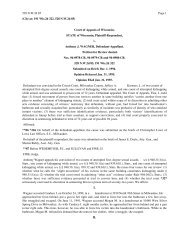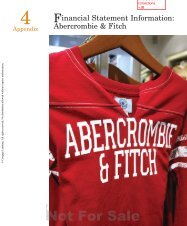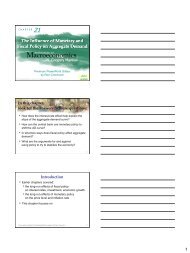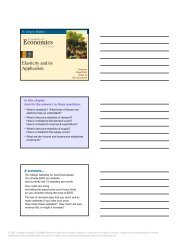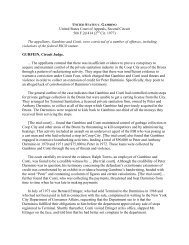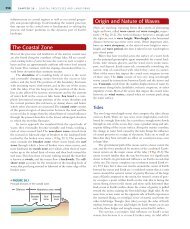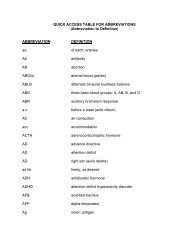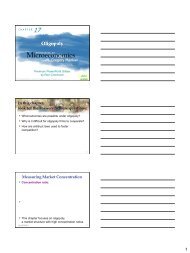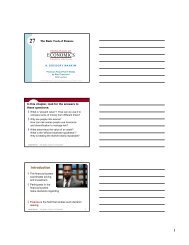Macroeconomics - Cengage Learning
Macroeconomics - Cengage Learning
Macroeconomics - Cengage Learning
Create successful ePaper yourself
Turn your PDF publications into a flip-book with our unique Google optimized e-Paper software.
N. Gregory Mankiw<br />
Brief Principles of<br />
<strong>Macroeconomics</strong><br />
Sixth Edition<br />
13<br />
Open-Economy<br />
<strong>Macroeconomics</strong>:<br />
Basic Concepts<br />
Premium<br />
PowerPoint<br />
Slides by<br />
Ron Cronovich<br />
In this chapter,<br />
look for the answers to these questions:<br />
• How are international flows of goods and assets<br />
related?<br />
• What’s the difference between the real and<br />
nominal exchange rate?<br />
• What is “purchasing-power parity,” and how does<br />
it explain nominal exchange rates?<br />
Introduction<br />
One of the Ten Principles of Economics<br />
from Chapter 1:<br />
Trade can make everyone better off.<br />
This chapter introduces basic concepts of<br />
international macroeconomics:<br />
The trade balance (trade deficits, surpluses)<br />
International flows of assets<br />
Exchange rates<br />
© 2012 <strong>Cengage</strong> <strong>Learning</strong>. All Rights Reserved. May not be copied, scanned, or duplicated, in whole or in part, except for use as permitted in<br />
a license distributed with a certain product or service or otherwise on a password-protected website for classroom use.<br />
1<br />
2
Closed vs. Open Economies<br />
A closed economy does not interact with other<br />
economies in the world.<br />
<br />
The Flow of Goods & Services<br />
Exports:<br />
domestically-produced g&s sold abroad<br />
Imports:<br />
foreign-produced g&s sold domestically<br />
<br />
A C T I V E L E A R N I N G 1<br />
Variables that affect NX<br />
What do you think would happen to<br />
U.S. net exports if:<br />
A. Canada experiences a recession<br />
(falling incomes, rising unemployment)<br />
B. U.S. consumers decide to be patriotic and<br />
buy more products “Made in the U.S.A.”<br />
C. Prices of goods produced in Mexico rise faster<br />
than prices of goods produced in the U.S.<br />
© 2012 <strong>Cengage</strong> <strong>Learning</strong>. All Rights Reserved. May not be copied, scanned, or duplicated, in whole or in part, except for use as<br />
permitted in a license distributed with a certain product or service or otherwise on a password-protected website for classroom use.<br />
© 2012 <strong>Cengage</strong> <strong>Learning</strong>. All Rights Reserved. May not be copied, scanned, or duplicated, in whole or in part, except for use as permitted in<br />
a license distributed with a certain product or service or otherwise on a password-protected website for classroom use.<br />
3<br />
4
A C T I V E L E A R N I N G 1<br />
Answers<br />
© 2012 <strong>Cengage</strong> <strong>Learning</strong>. All Rights Reserved. May not be copied, scanned, or duplicated, in whole or in part, except for use as<br />
permitted in a license distributed with a certain product or service or otherwise on a password-protected website for classroom use.<br />
Variables that Influence Net Exports<br />
Consumers’ preferences for foreign and<br />
domestic goods<br />
<br />
<br />
<br />
Transportation costs<br />
Govt policies<br />
Trade Surpluses & Deficits<br />
NX measures the imbalance in a country’s trade in<br />
goods and services.<br />
Trade deficit:<br />
Trade surplus:<br />
Balanced trade:<br />
© 2012 <strong>Cengage</strong> <strong>Learning</strong>. All Rights Reserved. May not be copied, scanned, or duplicated, in whole or in part, except for use as permitted in<br />
a license distributed with a certain product or service or otherwise on a password-protected website for classroom use.<br />
8<br />
9
Percent of GDP<br />
The U.S. Economy’s Increasing Openness<br />
20%<br />
18%<br />
16%<br />
14%<br />
12%<br />
10%<br />
8%<br />
6%<br />
4%<br />
2%<br />
0%<br />
1960 1965 1970 1975 1980 1985 1990 1995 2000 2005 2010<br />
The Flow of Capital<br />
Net capital outflow (NCO):<br />
NCO is also called<br />
The Flow of Capital<br />
Imports<br />
The flow of capital abroad takes two forms:<br />
Exports<br />
Foreign direct investment:<br />
Domestic residents actively manage the foreign<br />
investment, e.g., McDonalds opens a fast-food<br />
outlet in Moscow.<br />
Foreign portfolio investment:<br />
Domestic residents<br />
© 2012 <strong>Cengage</strong> <strong>Learning</strong>. All Rights Reserved. May not be copied, scanned, or duplicated, in whole or in part, except for use as permitted in<br />
a license distributed with a certain product or service or otherwise on a password-protected website for classroom use.<br />
11<br />
12
The Flow of Capital<br />
NCO measures the imbalance in a country’s trade<br />
in assets:<br />
When NCO > 0,<br />
When NCO < 0, “capital inflow”<br />
Foreign purchases of domestic assets exceed<br />
domestic purchases of foreign assets.<br />
Variables that Influence NCO<br />
<br />
<br />
<br />
Govt policies affecting foreign ownership of<br />
domestic assets<br />
The Equality of NX and NCO<br />
An accounting identity: NCO = NX<br />
arises because<br />
(and vice versa)<br />
When a foreigner purchases a good<br />
from the U.S.,<br />
© 2012 <strong>Cengage</strong> <strong>Learning</strong>. All Rights Reserved. May not be copied, scanned, or duplicated, in whole or in part, except for use as permitted in<br />
a license distributed with a certain product or service or otherwise on a password-protected website for classroom use.<br />
13<br />
14<br />
15
The Equality of NX and NCO<br />
When a U.S. citizen buys foreign goods,<br />
<br />
the U.S. buyer pays with U.S. dollars or<br />
assets, so<br />
Saving, Investment, and International<br />
Flows of Goods & Assets<br />
Y = C + I + G + NX accounting identity<br />
When S > I,<br />
When S < I,<br />
rearranging terms<br />
since S = Y – C – G<br />
since NX = NCO<br />
Case Study: The U.S. Trade Deficit<br />
The U.S. trade deficit reached record levels in<br />
2006 and remained high in 2007–2008.<br />
Recall, NX = S – I = NCO.<br />
A trade deficit means<br />
In 2007, foreign purchases of U.S. assets<br />
exceeded U.S. purchases of foreign assets by<br />
$775 million.<br />
Such deficits have been the norm since 1980…<br />
© 2012 <strong>Cengage</strong> <strong>Learning</strong>. All Rights Reserved. May not be copied, scanned, or duplicated, in whole or in part, except for use as permitted in<br />
a license distributed with a certain product or service or otherwise on a password-protected website for classroom use.<br />
16<br />
17<br />
18
(% of GDP)<br />
U.S. Saving, Investment, and NCO, 1950–2011<br />
24%<br />
21%<br />
18%<br />
15%<br />
12%<br />
9%<br />
6%<br />
3%<br />
0%<br />
-3%<br />
NCO<br />
Investment<br />
Saving<br />
-6%<br />
1960 1965 1970 1975 1980 1985 1990 1995 2000 2005 2010<br />
Case Study: The U.S. Trade Deficit<br />
Why U.S. saving has been less than investment:<br />
In the 1980s and early 2000s,<br />
In the 1990s,<br />
national saving increased as the economy grew,<br />
but<br />
Case Study: The U.S. Trade Deficit<br />
Is the U.S. trade deficit a problem?<br />
The extra capital stock from the ’90s investment<br />
boom may well yield large returns.<br />
The fall in saving of the ’80s and ’00s,<br />
while not desirable, at least did not depress<br />
domestic investment, since firms could borrow<br />
from abroad.<br />
A country, like a person, can go into debt<br />
for good reasons or bad ones.<br />
A trade deficit is not necessarily a problem,<br />
but might be a symptom of a problem.<br />
© 2012 <strong>Cengage</strong> <strong>Learning</strong>. All Rights Reserved. May not be copied, scanned, or duplicated, in whole or in part, except for use as permitted in<br />
a license distributed with a certain product or service or otherwise on a password-protected website for classroom use.<br />
20<br />
21
Case Study: The U.S. Trade Deficit<br />
as of 12-31-2009<br />
People abroad owned $21.1 trillion in U.S. assets.<br />
U.S. residents owned $18.4 trillion in foreign assets.<br />
U.S.’ net indebtedness to other countries = $2.7 trillion.<br />
Higher than every other country’s net indebtedness:<br />
So far, the U.S. earns higher interest rates on foreign<br />
assets than it pays on its debts to foreigners.<br />
But if U.S. debt continues to grow, foreigners may<br />
demand higher interest rates, and servicing the debt<br />
would become a drain on U.S. income.<br />
The Nominal Exchange Rate<br />
Nominal exchange rate:<br />
We express all exchange rates as foreign<br />
currency per unit of domestic currency.<br />
Appreciation and Depreciation<br />
Appreciation (or “strengthening”):<br />
as measured by the amount of foreign currency it<br />
can buy<br />
Depreciation (or “weakening”):<br />
as measured by the amount of foreign currency it<br />
can buy<br />
Examples: During 2007, the U.S. dollar…<br />
depreciated 9.5% against the Euro<br />
appreciated 1.5% against the S. Korean Won<br />
© 2012 <strong>Cengage</strong> <strong>Learning</strong>. All Rights Reserved. May not be copied, scanned, or duplicated, in whole or in part, except for use as permitted in<br />
a license distributed with a certain product or service or otherwise on a password-protected website for classroom use.<br />
22<br />
23<br />
24
The Real Exchange Rate<br />
Real exchange rate:<br />
Real exchange rate =<br />
where<br />
P =<br />
P* = foreign price (in foreign currency)<br />
e = nominal exchange rate, i.e., foreign<br />
currency per unit of domestic currency<br />
Example With One Good<br />
A Big Mac costs $2.50 in U.S., 400 yen in Japan<br />
e = 120 yen per $<br />
e x P =<br />
Compute the real exchange rate:<br />
e x P<br />
P*<br />
=<br />
=<br />
yen per U.S. Big Mac<br />
yen per Japanese Big Mac<br />
Interpreting the Real Exchange Rate<br />
“The real exchange rate =<br />
0.75 Japanese Big Macs per U.S. Big Mac”<br />
Correct interpretation:<br />
© 2012 <strong>Cengage</strong> <strong>Learning</strong>. All Rights Reserved. May not be copied, scanned, or duplicated, in whole or in part, except for use as permitted in<br />
a license distributed with a certain product or service or otherwise on a password-protected website for classroom use.<br />
25<br />
26<br />
27
A C T I V E L E A R N I N G 2<br />
Compute a real exchange rate<br />
e = 10 pesos per $<br />
price of a tall Starbucks Latte<br />
P = $3 in U.S., P* = 24 pesos in Mexico<br />
A. What is the price of a U.S. latte measured in<br />
pesos?<br />
B. Calculate the real exchange rate,<br />
measured as Mexican lattes per U.S. latte.<br />
© 2012 <strong>Cengage</strong> <strong>Learning</strong>. All Rights Reserved. May not be copied, scanned, or duplicated, in whole or in part, except for use as<br />
permitted in a license distributed with a certain product or service or otherwise on a password-protected website for classroom use.<br />
The Real Exchange Rate With Many Goods<br />
P =<br />
measures the price of a basket of goods<br />
P* =<br />
Real exchange rate<br />
= (e x P)/P*<br />
=<br />
If U.S. real exchange rate appreciates,<br />
The Law of One Price<br />
Law of one price:<br />
Suppose coffee sells for $4/pound in Seattle<br />
and $5/pound in Boston,<br />
and can be costlessly transported.<br />
There is an opportunity for _______________,<br />
making a quick profit by buying coffee in<br />
Seattle and selling it in Boston.<br />
<br />
© 2012 <strong>Cengage</strong> <strong>Learning</strong>. All Rights Reserved. May not be copied, scanned, or duplicated, in whole or in part, except for use as permitted in<br />
a license distributed with a certain product or service or otherwise on a password-protected website for classroom use.<br />
30<br />
31
Purchasing-Power Parity (PPP)<br />
Purchasing-power parity:<br />
based on the law of one price<br />
implies that<br />
Purchasing-Power Parity (PPP)<br />
Example: The “basket” contains a Big Mac.<br />
P = price of U.S. Big Mac (in dollars)<br />
P* = price of Japanese Big Mac (in yen)<br />
e = exchange rate, yen per dollar<br />
According to PPP,<br />
Solve for e:<br />
PPP and Its Implications<br />
PPP implies<br />
If the two countries have different inflation rates,<br />
then<br />
If inflation is higher in Mexico than in the U.S.,<br />
If inflation is higher in the U.S. than in Japan,<br />
then P rises faster than P*,<br />
© 2012 <strong>Cengage</strong> <strong>Learning</strong>. All Rights Reserved. May not be copied, scanned, or duplicated, in whole or in part, except for use as permitted in<br />
a license distributed with a certain product or service or otherwise on a password-protected website for classroom use.<br />
32<br />
33<br />
34
Limitations of PPP Theory<br />
Two reasons why exchange rates do not always<br />
adjust to equalize prices across countries:<br />
<br />
<br />
Examples: haircuts, going to the movies<br />
<br />
E.g., some U.S. consumers prefer Toyotas over<br />
Chevys, or vice versa<br />
<br />
Limitations of PPP Theory<br />
Nonetheless, PPP works well in many cases,<br />
especially as an explanation of long-run trends.<br />
For example, PPP implies:<br />
(relative to a low-inflation country like the US).<br />
The data support this prediction…<br />
Inflation & Depreciation in a Cross-Section<br />
of 31 Countries<br />
10,000.0<br />
Ukraine<br />
1,000.0<br />
Avg annual<br />
depreciation<br />
100.0<br />
relative to<br />
10.0<br />
US dollar<br />
1993–2003<br />
1.0<br />
(log scale)<br />
0.1<br />
Argentina<br />
Canada<br />
Japan<br />
Romania<br />
Kenya<br />
Mexico<br />
© 2012 <strong>Cengage</strong> <strong>Learning</strong>. All Rights Reserved. May not be copied, scanned, or duplicated, in whole or in part, except for use as permitted in<br />
a license distributed with a certain product or service or otherwise on a password-protected website for classroom use.<br />
35<br />
36<br />
Brazil<br />
0.1 1.0 10.0 100.0 1,000.0<br />
Avg annual CPI inflation<br />
1993–2003 (log scale)
A C T I V E L E A R N I N G 3<br />
Chapter review questions<br />
1. Which of the following statements about a country<br />
with a trade deficit is not true?<br />
A. Exports < imports<br />
B. Net capital outflow < 0<br />
C. Investment < saving<br />
D. Y < C + I + G<br />
2. A Ford Escape SUV sells for $24,000 in the U.S.<br />
and 720,000 rubles in Russia.<br />
If purchasing-power parity holds, what is the<br />
nominal exchange rate (rubles per dollar)?<br />
© 2012 <strong>Cengage</strong> <strong>Learning</strong>. All Rights Reserved. May not be copied, scanned, or duplicated, in whole or in part, except for use as<br />
permitted in a license distributed with a certain product or service or otherwise on a password-protected website for classroom use.<br />
© 2012 <strong>Cengage</strong> <strong>Learning</strong>. All Rights Reserved. May not be copied, scanned, or duplicated, in whole or in part, except for use as permitted in<br />
a license distributed with a certain product or service or otherwise on a password-protected website for classroom use.



